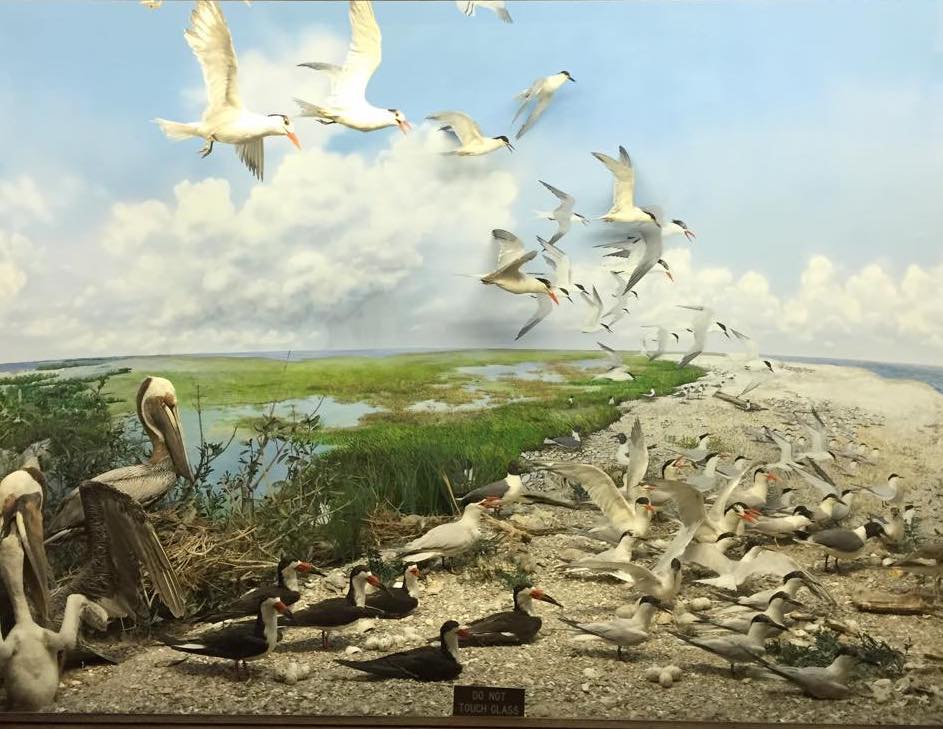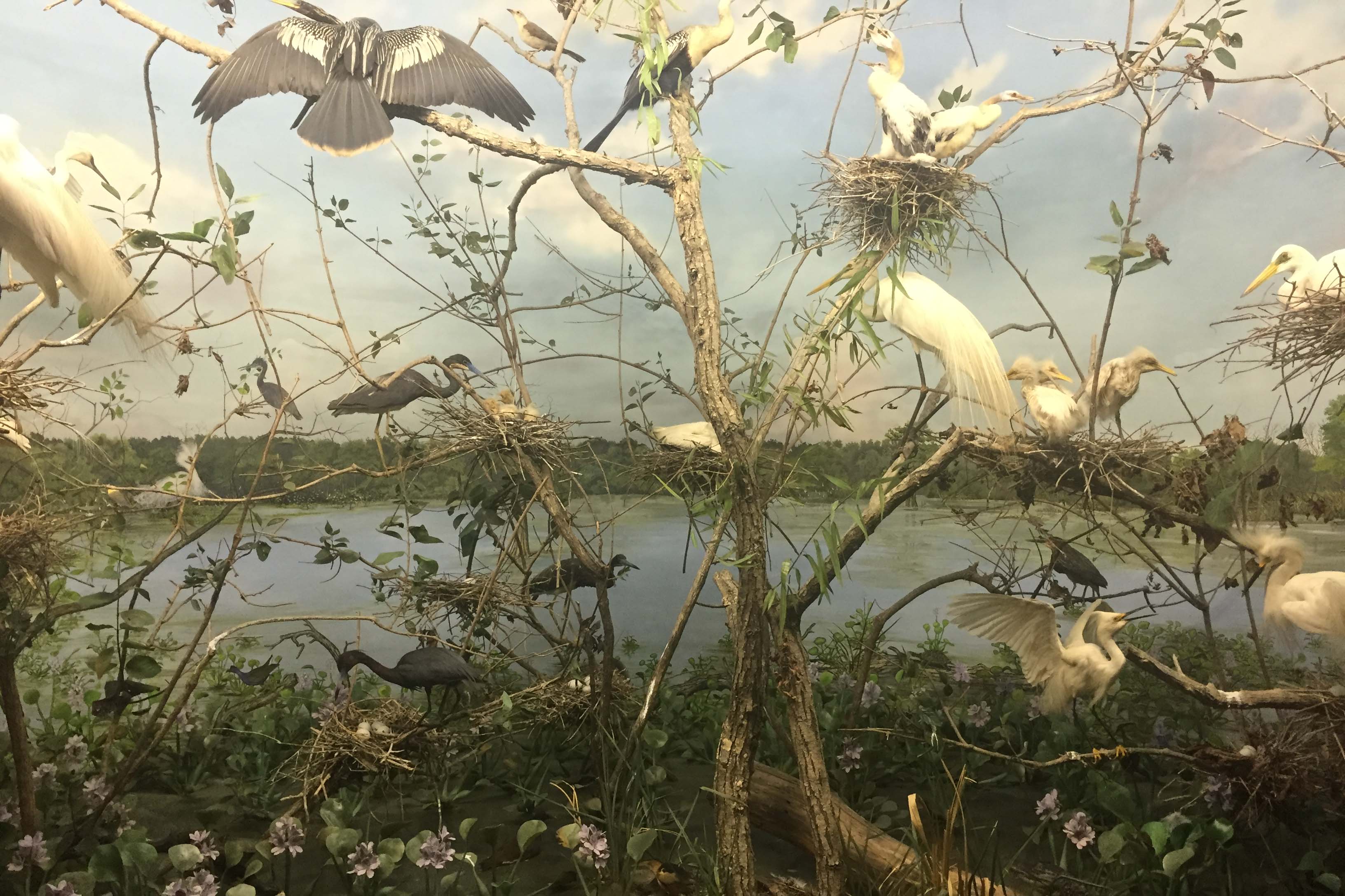Louisiana's Present
Waterfowl in a Louisiana Marsh

This scene from Cameron Parish was the first diorama to be completed in the Museum and at the time was the continent’s largest habitat group devoted exclusively to birds. It is composed of 62 geese and ducks.
Every winter ducks and geese assemble in Southern Louisiana in the greatest concentration to be found on the North American continent. Included among them are most of the Snow Geese to be found in the world! Of this great congregation, only a few will stay to rear their young.
Research and game management is necessary to provide a retreat for these migratory birds and to make land available for recreational hunting. More than 784,000 acres of marshland in southern Louisiana have been set aside as waterfowl refuges. Note that the display identifies Snow and Blue Geese, but since the diorama’s creation, it has been found that the Blue Goose is just a color phase of the Snow Goose. The southern part of our state is characterized by three types of marsh; fresh, brackish, and salt marshes. Louisiana contains 40% of all the North America salt marsh estuaries.
One of the problems facing the Louisiana coastline is the loss of 40 square acres of coastal marsh each year. Much of this is caused by channelization of rivers which prevents the natural flow of soils into the marshes to prevent erosion. Channels also allow salt water to intrude into freshwater areas which changes the vegetation. These vegetation changes affect the food source of the birds that winter here.
Short Facts
- More than 784,000 acres of marshland in southern Louisiana are set aside for waterfowl.
- Every winter, ducks and geese congregate in Louisiana’s marshes, resulting in largest concentration of waterfowl in the North American continent.
- Louisiana is losing an average of 34 square miles of land, primarily coastal marsh, per year for the last 50 years, mostly because of river channelization, which prevents natural input of soils into marshes and fight back erosion.
- Channels also allow salt water to intrude into freshwater areas which changes the vegetation, affecting the food source of the birds that winter here.
Teacher's Corner
Ask your children or students questions such as:
- Discuss the effects that men have on the coast of Louisiana and what we can do to protect this land.
- What is the difference between swamps and marshes?
- Why do we put our Christmas trees in the marsh? (To help trap sediments and build marshes).
- Emphasize how unique Louisiana is to have such magnificent wetlands and waterfowl!
Bird Life on a Coastal Island

This habitat diorama depicts barrier islands found along the coast of Louisiana. These islands support some of the largest bird colonies in the United States.
In the diorama, you can see what nesting on one of the barrier islands of Louisiana looks like. The birds that nest here actually help stabilize these islands by depositing nutrients in the soil that the plants need to grow, which helps in establishing vegetation.
These plants, in turn, help in preventing erosion of the beaches and in decreasing coastal shoreline recession. As most of these islands are lacking trees, most birds on these islands simply nest in the open and lay their eggs directly on the ground, protected by camouflaged shells. The eggs of terns are also pointed on one end so they will roll in circles rather than in a straight line away from the nest.
Once hatched, the young stay in the nest protected by one parent while the other searches for food. If left alone, the young could be pecked to death by other adults. Human visits to these islands during breeding season can be disastrous. When people approach the colony, the adult terns fly away from the nesting area, leaving the chicks and eggs unprotected. Gulls immediately move into the area and eat them.
Did you know that terns, gulls and skimmers each have unique ways of getting food from the water? Terns dive into the water in flight and retrieve fish. Gulls pick food from the surface or scavenge organisms brought in by the tide. Skimmers fly just above the water, dip their lower mandible onto the surface and flip prey into their mouth!
Short Facts
- The Terns’ camouflaged eggs are pointed at one end, which allows them to roll in a circle than in a straight line away from the nest if they are disturbed.
- Newly hatched Pelicans drink regurgitated fish “soup” from the parent’s pouch. Older pelicans will reach down into their parent’s gullet to retrieve the fish to eat.
- Terns dive into the water to catch fish;
Gulls pick up food from the surface of the water or the beach. - Skimmers fly just above the water and skim the surface with their lower mandible to catch their food.
Teacher's Corner
Ask your children or students questions such as:
- What difference in the terns, gulls, and skimmers appearances help them obtain food
- Do all of the eggs look exactly the same?
- Why do you think the vegetation on barrier islands is so short? Think about salty conditions.
- There are two different kinds of nests here, what are they?
A Heronry in South Louisiana

Twice their weight in gold! Such was the value once placed on “aigrettes” – the lacy white plumes raised in displays by many herons and egrets. These beautiful feathers were used to decorate hats, and to keep up with demand, plume hunters sought out the immense breeding colonies where herons and egrets gathered each year, and slaughtered adult birds by the thousands.
By the early 1900’s few Great or Snowy Egrets remained in the United States. Conservationists like Edward McIlhenny recognized their plight, and set aside swampland to serve as a refuge for these magnificent birds. This diorama represents a scene from Avery Island, or also known as “Bird City” and pays tribute to the efforts of Edward McIlhenny in establishing an area for herons to breed in South Louisiana and encouraged young egrets to nest at Avery Island with the hopes they would return to nest there again.
His efforts succeeded and the birds established a colony at the site. He started with 7 birds and at one point the population had grown to 100,000 birds! Today, these birds have made a remarkable comeback and can be seen across the American wetlands.
There are still over 20,000 birds that nest at Avery Island each year. This site is open to the public and the best time to visit is between mid-February and late April. This display presents 32 birds, an alligator, a bullfrog, and a water moccasin.
Short Facts
- Herons and Egrets do not have webbed feet. They wade in shallow water to catch fish and frogs for food.
- Young Herons and Egrets are born with their eyes open and a full covering of down.
- By the early 1800s, only a few Great and Snowy Egrets had survived the slaughter of plume hunters.
- This display includes 32 birds, an alligator, a bullfrog and a water moccasin.
Teacher's Corner
Ask your children or students questions such as:
- Discuss the effects humans can have on bird populations.
- Are the feet of the herons webbed like those of ducks? (No) Why? Do they swim or just wade?
- How does their long bill help them?